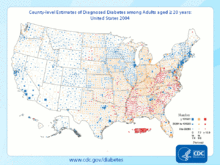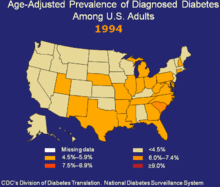Epidemiology of diabetes: Difference between revisions
moved from diabetes mellitus please see for edit history |
(No difference)
|
Revision as of 21:30, 1 June 2013


Globally, as of 2010[update], an estimated 285 million people had diabetes, with type 2 making up about 90% of the cases.[1] Its incidence is increasing rapidly, and by 2030, this number is estimated to almost double.[2] Diabetes mellitus occurs throughout the world, but is more common (especially type 2) in the more developed countries. The greatest increase in prevalence is, however, expected to occur in Asia and Africa, where most patients will probably be found by 2030.[2] The increase in incidence in developing countries follows the trend of urbanization and lifestyle changes, perhaps most importantly a "Western-style" diet. This has suggested an environmental (i.e., dietary) effect, but there is little understanding of the mechanism(s) at present, though there is much speculation, some of it most compellingly presented.[2]
Australia
Indigenous populations in first world countries have a higher prevalence and increasing incidence of diabetes than their corresponding nonindigenous populations. In Australia, the age-standardised prevalence of self-reported diabetes in indigenous Australians is almost four times that of nonindigenous Australians.[3] Preventative community health programs, such as Sugar Man (diabetes education), are showing some success in tackling this problem.
China
Almost one Chinese adult in ten has diabetes. A 2010 study estimated that more than 92 million Chinese adults have the disease, with another 150 million showing early symptoms.[4] The incidence of the disease is increasing rapidly; a 2009 study found a 30% increase in 7 years.[5]
India
India has more diabetics than any other country in the world, according to the International Diabetes Foundation,[6] although more recent data suggest that China has even more.[4] The disease affects more than 50 million Indians - 7.1% of the nation's adults - and kills about 1 million Indians a year.[6] The average age on onset is 42.5 years.[6] The high incidence is attributed to a combination of genetic susceptibility plus adoption of a high-calorie, low-activity lifestyle by India's growing middle class.[7]
United Kingdom
About 3.8 million people in the United Kingdom have diabetes mellitus, but the charity Diabetes U.K. have made predictions that that could become high as 6.2 million by 2035/2036. Diabetes U.K. have also predicted that theNational Health Service could be spending as much as 16.9 billion pounds on diabetes mellitus by 2035, a figure that means the NHS could be spending as much as 17% of its budget on diabetes treatment by 2035.[8][9][10]
United States


For at least 20 years, diabetes rates in North America have been increasing substantially. In 2010, nearly 26 million people have diabetes in the United States, of whom 7 million people remain undiagnosed. Another 57 million people are estimated to have prediabetes.[11][12]
The Centers for Disease Control and Prevention (CDC) has termed the change an epidemic.[13] The National Diabetes Information Clearinghouse estimates diabetes costs $132 billion in the United States alone every year. About 5%–10% of diabetes cases in North America are type 1, with the rest being type 2. The fraction of type 1 in other parts of the world differs. Most of this difference is not currently understood. The American Diabetes Association (ADA) cites the 2003 assessment of the National Center for Chronic Disease Prevention and Health Promotion (Centers for Disease Control and Prevention) that one in three Americans born after 2000 will develop diabetes in their lifetimes.[14][15]
According to the ADA, about 18.3% (8.6 million) of Americans age 60 and older have diabetes.[16] Diabetes mellitus prevalence increases with age, and the numbers of older persons with diabetes are expected to grow as the elderly population increases in number. The National Health and Nutrition Examination Survey (NHANES III) demonstrated, in the population over 65 years old, 18% to 20% have diabetes, with 40% having either diabetes or its precursor form of impaired glucose tolerance.[17]
References
- ^ Cite error: The named reference
Will2011was invoked but never defined (see the help page). - ^ a b c Wild S, Roglic G, Green A, Sicree R, King H (2004). "Global prevalence of diabetes: Estimates for the year 2000 and projections for 2030". Diabetes Care. 27 (5): 1047–53. doi:10.2337/diacare.27.5.1047. PMID 15111519.
{{cite journal}}: CS1 maint: multiple names: authors list (link) - ^ Australian Institute for Health and Welfare. "Diabetes, an overview". Archived from the original on 2008-06-17. Retrieved 2008-06-23.
- ^ a b "China faces 'diabetes epidemic', research suggests". BBC. March 25, 2010. Retrieved 8 June 2012.
- ^ Grens, Kerry (April 4, 2012). "Diabetes continuing to spike in China". Reuters. Retrieved 8 June 2012.
- ^ a b c Gale, Jason (November 7, 2010). "India's Diabetes Epidemic Cuts Down Millions Who Escape Poverty". Bloomberg. Retrieved 8 June 2012.
- ^ Kleinfield, N. R. (September 13, 2006). "Modern Ways Open India's Doors to Diabetes". New York Times. Retrieved 8 June 2012.
- ^ "NHS spending on diabetes 'to reach £16.9 billion by 2035'". 2012-04-25. Retrieved 2012-04-26.
- ^ http://managingdiabetes.co.uk/articles/diabetesnhsspending.php
- ^ http://www.nhs.uk/news/2012/04april/Pages/nhs-diabetes-costs-cases-rising.aspx
- ^ "Number of Americans with Diabetes Rises to Nearly 26 Million" (Press release). Centers for Disease Control and Prevention. 2011-01-26. Retrieved 2012-05-27.
- ^ "National diabetes fact sheet: national estimates and general information on diabetes and prediabetes in the United States, 2011" (PDF). Centers for Disease Control and Prevention. 2011. Retrieved 2012-05-31.
- ^ "Diabetes Rates Rise Another 6 Percent in 1999 — January 26, 2001". Retrieved 2008-06-23.
- ^ Narayan KM, Boyle JP, Thompson TJ, Sorensen SW, Williamson DF (2003). "Lifetime risk for diabetes mellitus in the United States". JAMA. 290 (14): 1884–90. doi:10.1001/jama.290.14.1884. PMID 14532317.
{{cite journal}}: Unknown parameter|month=ignored (help)CS1 maint: multiple names: authors list (link) - ^ "Total Prevalence of Diabetes & Pre-diabetes". American Diabetes Association. 2005. Archived from the original on 2006-02-08. Retrieved 2006-03-17.
- ^ "Seniors and Diabetes". Elderly And Diabetes-Diabetes and Seniors. LifeMed Media. 2006. Retrieved 2007-05-14.
- ^ Harris MI, Flegal KM, Cowie CC, Eberhardt MS, Goldstein DE, Little RR, Wiedmeyer HM, Byrd-Holt DD (1998). "Prevalence of diabetes, impaired fasting glucose, and impaired glucose tolerance in U.S. adults. The Third National Health and Nutrition Examination Survey, 1988–1994". Diabetes Care. 21 (4): 518–24. doi:10.2337/diacare.21.4.518. PMID 9571335.
{{cite journal}}: Unknown parameter|month=ignored (help)CS1 maint: multiple names: authors list (link)
